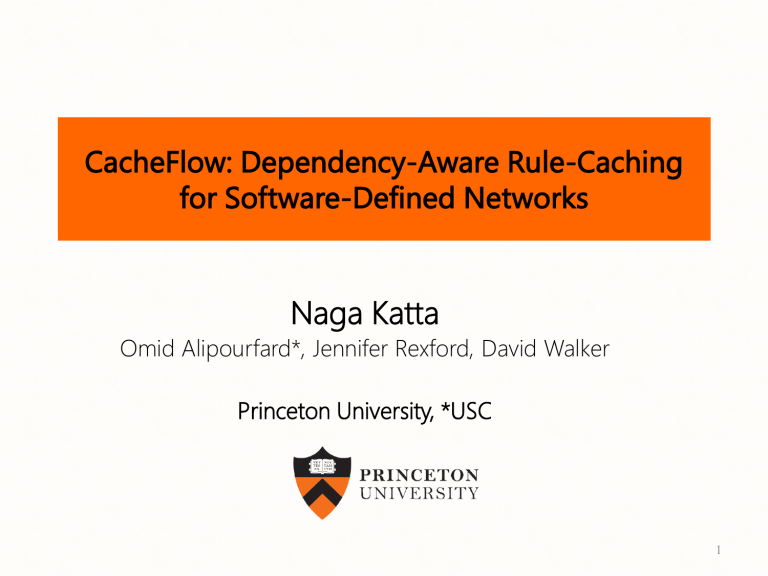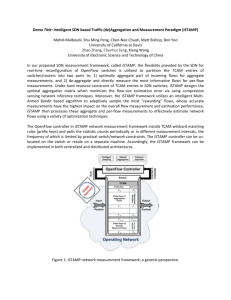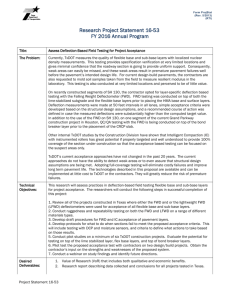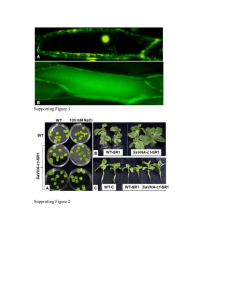Naga Katta CacheFlow: Dependency-Aware Rule-Caching for Software-Defined Networks
advertisement

CacheFlow: Dependency-Aware Rule-Caching for Software-Defined Networks Naga Katta Omid Alipourfard*, Jennifer Rexford, David Walker Princeton University, *USC 1 Inadequate Switching Gear 2 SDN Promises Flexible Policies Controller Switch TCAM 3 SDN Promises Flexible Policies Lot of finegrained rules Controller Switch TCAM 4 SDN Promises Flexible Policies Lot of finegrained rules Controller 5 SDN Promises Flexible Policies Lot of finegrained rules Controller 6 SDN Promises Flexible Policies Lot of finegrained rules Controller 7 SDN Promises Flexible Policies Controller Limited rule space! 8 SDN Promises Flexible Policies What now? Controller Limited rule space! 9 State of the Art Hardware Switch Software Switch Rule Capacity Low (~2K-10K) High Lookup Throughput High (>400Gbps) Low (~40Gbps) Port Density High Low Cost Expensive Relatively cheap 10 TCAM as cache Controller CacheFlow Software Switches S1 S2 TCAM 11 TCAM as cache Controller CacheFlow <5% rules cached S1 S2 TCAM 12 TCAM as cache Controller CacheFlow low expected cache-misses S1 S2 TCAM 13 TCAM as cache • High throughput + high rule space Controller CacheFlow S1 S2 TCAM 14 TCAM as cache • High throughput + high rule space Controller CacheFlow Flexible Deployment S1 S2 TCAM 15 A Correct, Efficient and Transparent Caching System • Abstraction of an “infinite” switch Correct: realizes the policy Efficient: high throughput & large tables Transparent: unmodified applications/switches 16 1. Correct Caching 17 Caching under constraints Rule Match Action Priority Traffic R1 110 Fwd 1 3 10 R2 100 Fwd 2 2 60 R3 101 Fwd 3 1 30 Easy: Cache rules greedily 18 Caching Ternary Rules Rule Match Action Priority Traffic R1 11* Fwd 1 3 10 R2 1*0 Fwd 2 2 60 R3 10* Fwd 3 1 30 • Greedy strategy breaks rule-table semantics 19 Caching Ternary Rules Rule Match Action Priority Traffic R1 11* Fwd 1 3 10 R2 1*0 Fwd 2 2 60 R3 10* Fwd 3 1 30 Rules Overlap! • Greedy strategy breaks rule-table semantics 20 Caching Ternary Rules Rule Match Action Priority Traffic R1 11* Fwd 1 3 10 R2 1*0 Fwd 2 2 60 R3 10* Fwd 3 1 30 Rules Overlap! • Greedy strategy breaks rule-table semantics • Beware of switches that claim large rule tables 21 Dependency Graph Rule Match Action Priority Traffic R1 0000 Fwd 1 6 10 R2 000* Fwd 2 5 20 R3 00** Fwd 3 4 90 R4 111* Fwd 4 3 5 R5 11** Fwd 5 2 10 R6 1*** Fwd 6 1 120 R1 R4 R2 R5 R3 R6 (*) 22 How to get the dependency graph? • For a given rule R • Find all the rules that its packets may hit if R is removed R R1 R ∧ R1 != φ R2 R3 R4 23 How to get the dependency graph? • For a given rule R • Find all the rules that its packets may hit if R is removed R R1 R ∧ R1 != φ R2 R3 R4 24 How to get the dependency graph? • For a given rule R • Find all the rules that its packets may hit if R is removed R R1 R’ = R – R1 R2 R3 R4 25 How to get the dependency graph? • For a given rule R • Find all the rules that its packets may hit if R is removed R R1 R2 R’ ∧ R2 == φ R3 R4 26 How to get the dependency graph? • For a given rule R • Find all the rules that its packets may hit if R is removed R R1 R2 R3 R’ ∧ R3 != φ R4 27 How to get the dependency graph? • For a given rule R • Find all the rules that its packets may hit if R is removed R R1 R2 R3 R’ ∧ R3 != φ R4 28 How to get the dependency graph? • For a given rule R • Find all the rules that its packets may hit if R is removed R R1 R2 R3 R’’ = R’ – R3 R4 29 How to get the dependency graph? • For a given rule R • Find all the rules that its packets may hit if R is removed R R1 R2 R3 R’’ == φ R4 (End of dependencies originating from R) 30 Dependency Graph Rule Match Action Priority Traffic R1 0000 Fwd 1 6 10 R2 000* Fwd 2 5 20 R3 00** Fwd 3 4 90 R4 111* Fwd 4 3 5 R5 11** Fwd 5 2 10 R6 1*** Fwd 6 1 120 R1 R4 R2 R5 R3 R6 (*) 31 Multi-field ternary match -> complex DAG Rule R1 (dst_ip, dst_port) (10.10.10.10/32, 10) Ternary Action Match Priority 000 6 Fwd 1 R1 R4 110 000 R2 (10.10.10.10/32, *) 00* Fwd 2 5 R3 (10.10.0.0/16, *) 0** Fwd 3 4 R4 (11.11.11.11/32, *) 11* Fwd 4 3 R5 (11.11.0.0/16, 10) 1*0 Fwd 5 2 R6 (11.11.10.10/32, *) 10* Fwd 6 1 R2 R5 111 100 00* R3 110 0** R6 10* (*) 32 Incremental Updates 33 Complex dependencies in the wild Reanzz Network CoVisor (NSDI’15) 34 Dependency-aware Caching 35 Dependent-Set Caching • All descendants in DAG are dependents • Cache dependent rules for correctness R1 R4 R2 R5 R3 R6 (*) 36 2. Efficient Caching 37 Dependent-Set Overhead Too Costly? R1 R4 R2 R5 R3 R6 (*) 38 Cover-Set R4 R5 R1 R2 R5^ R3 R6 (*) Rule Match Action R1 000 Fwd 1 R2 00* Fwd 2 R3 0** Fwd 3 R4 11* Fwd 4 R5 1*0 Fwd 5 R5^ 1*0 To_SW R6 10* Fwd 6 (*) *** To_SW Cover rule 39 Dependency Splicing reduces rule cost! Cover-Set Dependent-Set Rule Space Cost 40 Mixed Set: Best of both worlds CacheFlow R4 R1 R5 R2 R5^ R3 R6 (*) 41 Dependency Chains – Clear Gain • CAIDA packet trace 3% rules 85% traffic 42 Incremental update is more stable 43 3. Transparent Caching 44 3. Transparent Design Controller OpenFlow Datapath CacheFlow S1 S2 S 3 S4 HW_Cache (TCAM) 45 3. Transparent Design Controller OpenFlow Datapath CacheFlow Virtual switch S1 S2 S 3 S4 HW_Cache (TCAM) 46 3. Transparent Design Emulates counters, barriers, timeouts etc. Controller OpenFlow Datapath CacheFlow Virtual switch S1 S2 S 3 S4 HW_Cache (TCAM) 47 Conclusion • Rule caching for OpenFlow rules Dependency analysis for correctness Splicing dependency chains for efficiency Transparent design 48 Conclusion • Rule caching for OpenFlow rules Dependency analysis for correctness Splicing dependency chains for efficiency Transparent design Get ready for infinite Ca$hflow! 49 Thank You 50 Backup Slides 51 Dependency Chains – Clear Gain • Stanford Backbone Router Config 52








